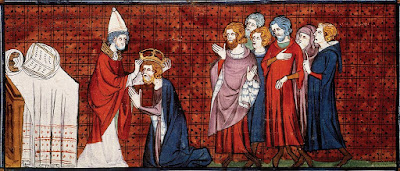As a strong female, she had a role model in her mother, Beatrice of Lorraine, who managed the regency of Matilda's brother Frederick and made alliances with other important political and religious figures. Beatrice was supportive of church and papal reforms, such as those proposed by Pope Gregory VII. Beatrice re-married; her choice of second husband was Godfrey the Bearded, Duke of Upper Lorraine, who had openly rebelled against Holy Roman Emperor Henry III. Henry, angered by her choice of his enemy as her husband, had Beatrice and Matilda arrested in 1055 and taken to Germany (Godfrey evaded capture). Henry died a year later, and the regency of his successor, the very young Henry IV, saw Godfrey reconciled with Henry's family and the women released. Upon their return to Italy, the pope (now Victor II) made clear that he valued the House of Canossa.
Matilda was understandably not inclined to look kindly on the family of her German captors. She supported Pope Gregory and his reform movement over Henry IV's choice of the Antipope Clement III. This led at a later date to Henry's forces ravaging parts of Tuscany.
Matilda was betrothed to Godfrey the Bearded's son from an earlier marriage, Godfrey the Hunchback. The elder Godfrey died on 30 December 1069 in Verdun, and records of the event tell us that Matilda was present and describe her as the wife of Godfrey the Hunchback.
The marriage was a way to consolidate Tuscany and Lorraine, but it was otherwise not typical. The two had a daughter, Beatrice, who died within a year, and the couple lived apart. Godfrey, perhaps because he learned from family history the dangers of crossing the Holy Roman Emperor, chose to support Henry IV in the Investiture Controversy, despite his wife's feelings and public stand on the matter.
By this time Beatrice—still co-regent with her daughter—was preparing her daughter for sole rule, encouraging her to be in charge of decisions and charters. When Beatrice died in 1076, Matilda became sole ruler of her parents' real estate possessions. Life was not simple, however. Godfrey had been assassinated (while relieving himself) two months earlier; if Beatrice had died first, Matilda's husband would have taken possession of her estates. As it happens, the deaths happened within a couple months in just the right order to make Matilda more powerful.
Suspicion fell on her for their deaths, as well as another accusation regarding her relationship to the pope. Let's dig into that, and into her career as ruler, next time.





